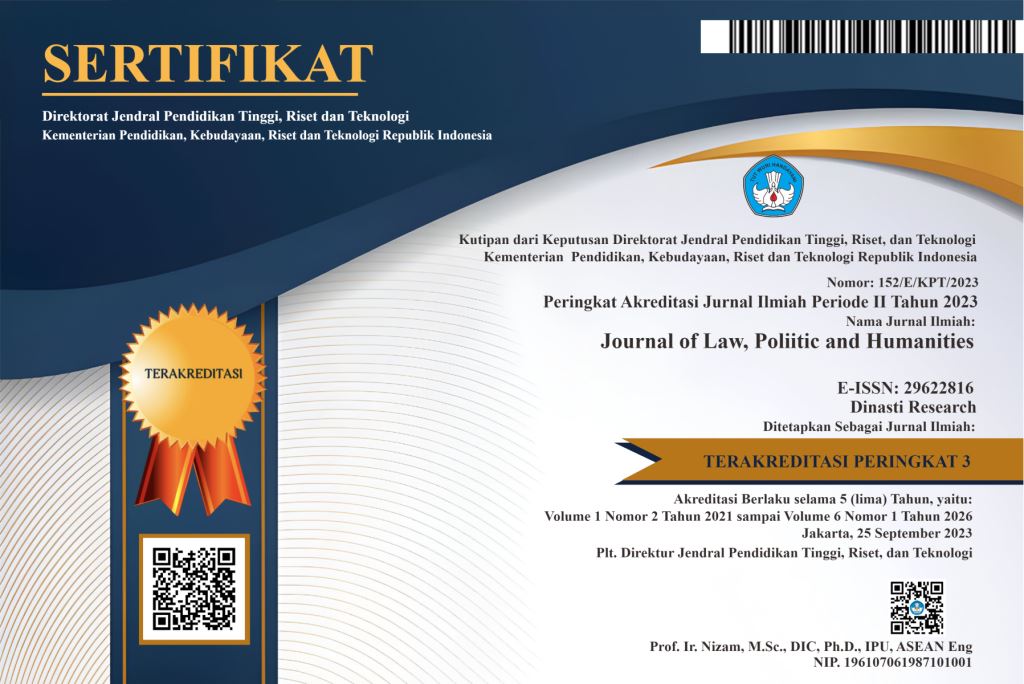Evidence Using Forensic Laboratory in Revealing the Crime of Murder
DOI:
https://doi.org/10.38035/jlph.v3i3.225Abstract
Murder is an act committed by anyone who intentionally takes the life of another person. The process of disclosing the crime of murder can be assisted by involving forensic laboratories in it. This study aims to analyze the role of forensic laboratories and the efforts made by the National Police to involve forensic laboratories in evidence to help reveal the crime of murder based on Decision Number 111/Pid.B/2015/PN Spg. The theories used included the legal theory of evidence and the theory of law enforcement. The analysis used in this research is a qualitative descriptive analysis. The results showed that the function and role of forensic laboratories in relation to the judicial process as a means of proof in court is to corroborate/give certainty to information, determine cause-and-effect relationships, prove whether or not certain factors or phenomena are true, make laws or arguments from a phenomenon if it has been proven true, and be a means of proof in court in determining the causes of death of a person so that it will be more supportive in the criminal justice process.
References
Bigenwald, A., & Chambon, V. (2019). Criminal Responsibility and Neuroscience: No Revolution Yet. Frontiers in Psychology, 10. https://doi.org/10.3389/fpsyg.2019.01406
Bowen, G. A. (2009). Document Analysis as a Qualitative Research Method. Qualitative Research Journal, 9(2), 27–40. https://doi.org/10.3316/QRJ0902027
Budianto, A. (2022). Legal Research Methodology Reposition in Research on Social Science. International Journal of Criminology and Sociology, 9, 1339–1346. https://doi.org/10.6000/1929-4409.2020.09.154
Chazawi, A. (2010). Pelajaran Hukum Pidana 1, Bagian 1; Stelsel Pidana, Tindak Pidana, Teori-Teori Pemidanaan & Batas (5th ed.). PT. Rajagrafindo Persada.
Ediwarman. (2014). Penegakan Hukum Pidana dalam Perspektif Kriminologi. Genta Publishing.
Koenane, M. L. J. (2017). Euthanasia in South Africa: Philosophical and theological considerations. Verbum et Ecclesia, 38(1). https://doi.org/10.4102/ve.v38i1.1549
Lamintang, P. A. F., & Lamintang, F. T. (2022). Dasar-dasar hukum pidana di Indonesia. Sinar Grafika.
Manurung, A., Hakim, A., Jannah, M., & Risdalina. (2023). The Existence of POLRI in Handling Minor Crimes of Defamation Through Social Media in the Electronic Information and Transaction Law. The Existence of POLRI in Handling Minor Crimes of Defamation Through Social Media in the Electronic Information and Transaction Law, 3(1). https://doi.org/https://doi.org/10.31763/iota.v3i1.59
Prodjodikoro, W. (2013). Tindak-Tindak Pidana Tertentu di Indonesia. Refika Aditama.
Putri, M., Danil, E., & Mulyati, N. (2019). Legal Standing of Testimonium De Auditu on Child Sex Crime. International Journal of Multicultural and Multireligious Understanding2, 6(6). https://doi.org/http://dx.doi.org/10.18415/ijmmu.v6i6.1275
Rinaldo, R., & Soponyono, E. (2022). The Role of the Inafist Dactyloscopy in the Murder Investigation Process (Case study at Polda Central Java). International Journal of Social Science And Human Research, 05(12). https://doi.org/10.47191/ijsshr/v5-i12-81
Sari, I. (2020). PERBUATAN MELAWAN HUKUM (PMH) DALAM HUKUM PIDANA DAN HUKUM PERDATA. Jurnal Ilmiah Hukum Dirgantara–Fakultas Hukum Universitas Dirgantara Marsekal Suryadarma, 11(1).
Sembiring, J., & Sofian, A. (2021). Causality Teaching Application on Criminal Actions Due to Death Case in Hospital Over Decision of Supreme Court Indonesia Republic No. 1110 K/Pid.Sus/2012. Journal of Multidisciplinary Academica, 5(4).
Sudarto, S., & Barthos, M. (2022). Juridical Review of The Power of Evidence Local Examination in Proof Civil Jurisdiction. Proceedings of the 2nd International Conference on Law, Social Science, Economics, and Education, ICLSSEE 2022, 16 April 2022, Semarang, Indonesia. https://doi.org/10.4108/eai.16-4-2022.2320073
Sugiarto, A. (2022). Criminal Law Politics Renewal of The National KUHP Against the Criminal Actions of Lesbian, Gay, Bisexual, Transgender (LGBT). Journal of World Science, 1(12), 1203–1214. https://doi.org/10.58344/jws.v1i12.169
Sumali, Bhirini Slamet, A., & Monique, C. (2022). Scientific Criminal Investigation Legal Studies in the Police Investigation Process. KnE Social Sciences. https://doi.org/10.18502/kss.v7i15.12105
Yip, C., Han, N.-L., & Sng, B. (2016). Legal and ethical issues in research. Indian Journal of Anaesthesia, 60(9), 684. https://doi.org/10.4103/0019-5049.190627
Downloads
Published
How to Cite
Issue
Section
License
Authors who publish their manuscripts in this journal agree to the following conditions:
- The copyright on each article belongs to the author(s).
- The author acknowledges that the Journal of Law, Poliitic and Humanities (JLPH) has the right to be the first to publish with a Creative Commons Attribution 4.0 International license (Attribution 4.0 International (CC BY 4.0).
- Authors can submit articles separately, arrange for the non-exclusive distribution of manuscripts that have been published in this journal into other versions (e.g., sent to the author's institutional repository, publication into books, etc.), by acknowledging that the manuscript has been published for the first time in the Journal of Law, Poliitic and Humanities (JLPH).


























